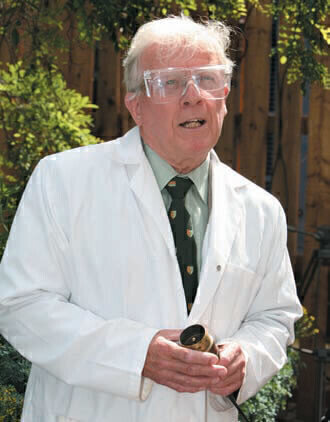News & Views
Rocket Fuel Research Celebrated on Anniversary of Moon Landing
Oct 08 2009
When the lunar module took off from the surface of the moon 40 years ago Neil Armstrong and Buzz Aldrin were relying on 4 cubic tonnes of N2O4 — one of the most important rocket propellants ever developed — to return them to lunar orbit and rendezvous with the Apollo Command and Service Module. This short, but crucial journey had its origins in research carried out in 1947 by PhD student Ray Thompson of Nottingham University, who wrote his Master’s thesis on the use of liquid N2O4 — laying the foundations for the chemical reaction used to fire the lunar module off the face of the moon. His work appeared in a series of papers from the research group led by the late Professor Clifford Addison in the School of Chemistry, which were published in the Journal of Chemical Society in the early 1950s; in 1969, the university was approached by NASA to help solve a problem that could been disastrous for the American space programme. NASA needed to find out why N2O4 was causing blockages in the filters and fuel lines onboard NASA space rockets and corrosion in the stainless steel and titanium fuel storage tanks.
The late Professor Clifford Addison and Dr Norman Logan, from the School of Chemistry, were able to pinpoint the iron compound that was causing the corrosion. The blockages and damage were all down to very small amounts of a very sophisticated type of rust — a type of iron nitrate formed by corrosion of the stainless steel propellant tanks and first synthesised and studied in pure form in Dr Logan’s PhD research during the late 1950s.
Dr Logan said: “Since the Apollo era a large number of space craft using liquid N2O4 propellant, such as the Space Shuttle, Ariane and communications satellites have benefitted from the research carried out at The University of Nottingham. This work spanned 50 years from 1947 to 1997.”
On July 20th, the 40th anniversary of the first landing of a man on the moon, Dr Logan returned to The University of Nottingham to see the re-enactment of one of Ray Thompson’s experiments. Professor Martyn Poliakoff and Dr Pete Licence used the exact same model rocket that Dr Logan used in a demonstration lecture given to a large number of school, university and other audiences between 1970 and 1995.
Professor Martyn Poliakoff, from the School of Chemistry, said: “It is great to have the opportunity to celebrate this pioneering chemistry research and its links with the Apollo moon landing. Let us hope that current research at Nottingham will prove equally significant in 40 years time.”
Digital Edition
Lab Asia 31.2 April 2024
April 2024
In This Edition Chromatography Articles - Approaches to troubleshooting an SPE method for the analysis of oligonucleotides (pt i) - High-precision liquid flow processes demand full fluidic c...
View all digital editions
Events
Apr 28 2024 Montreal, Quebec, Canada
May 05 2024 Seville, Spain
InformEx Zone at CPhl North America
May 07 2024 Pennsylvania, PA, USA
May 14 2024 Oklahoma City, OK, USA
May 15 2024 Birmingham, UK


















